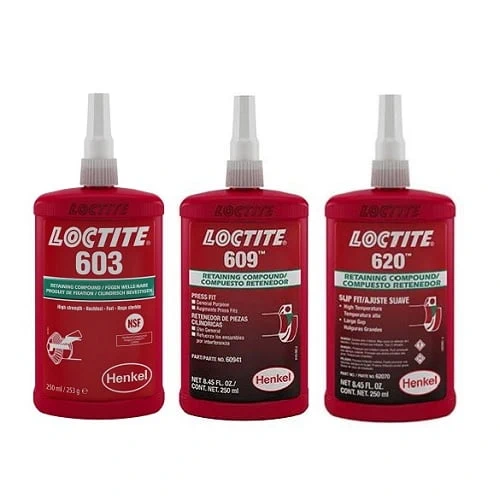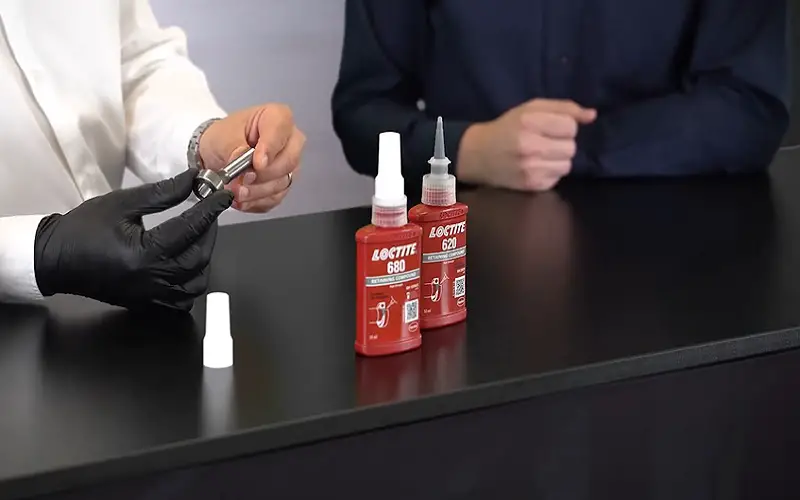Loctite 620 and 680 are two popular adhesives used in different applications. Loctite 620 is a high-strength retaining compound suitable for cylindrical parts, while Loctite 680 is a high-strength retaining compound designed specifically for close-fitting parts.
Both adhesives provide excellent bonding performance and offer resistance to temperature, chemicals, and vibrations.
Contents
Loctite 620 Vs Loctite 680
Chemical Composition
Loctite 620 and 680 are widely used industrial adhesives known for their strength and reliability. One crucial aspect to consider when comparing the two is their chemical composition.
Understanding the components of each adhesive will shed light on their unique qualities and applications. Let’s delve into the chemical composition of Loctite 620 and 680 to see how they differ.
Components Of Loctite 620
Loctite 620 is a high-temperature, high-strength retaining compound. Its chemical composition consists of:
- Dimethacrylate Ester
- Hydroxyalkyl Methacrylate Ester
- Maleic Acid Ester
- Aliphatic Amine
- Alkyl Methacrylate
Components Of Loctite 680
Loctite 680, on the other hand, is a high-strength, high-temperature retaining compound with a different chemical makeup.
Its components include:
- Methacrylated Oligomer
- Tetramethylene Diamine
- Hydroxyalkyl Methacrylate
- Benzoate Ester
- Aliphatic Amine
Strength And Durability
When it comes to choosing the right adhesive for your application, understanding the strength and durability of Loctite 620 and 680 is crucial.
These two products offer different properties that can make a significant impact on the longevity and reliability of your assembly.
Comparing The Strength Of Loctite 620
Loctite 620 is renowned for its exceptional strength, making it ideal for applications that require high bond strength and resistance to shock, vibration, and impact.
The adhesive creates a robust bond between cylindrical fitting parts, ensuring a reliable and long-lasting joint.
Its high strength formulation makes it suitable for demanding applications, such as heavy equipment, automotive components, and industrial machinery.
Comparing The Durability Of Loctite 680
When it comes to durability, Loctite 680 excels with its outstanding resistance to heat, chemicals, and environmental factors.
This adhesive is designed to withstand harsh conditions, making it perfect for applications where prolonged exposure to extreme temperatures or aggressive substances is a concern.
The long-term durability of Loctite 680 ensures that bonded parts remain secure and intact, even in challenging operating environments.
Applications
Common Applications Of Loctite 620
- Used for cylindrical parts and interference fits
- Effective for retaining bearings, bushings, and gears
- Ideal for high-strength structural bonding in machinery
Common Applications Of Loctite 680
- Designed for larger clearance gaps and cylindrical parts
- Excellent for securing rotor to shaft, pulleys, and keyways
- Used in applications requiring rapid curing and high strength
Curing Time
When it comes to adhesive solutions, the curing time is a crucial factor to consider. Whether you are working on a DIY project or a professional application, understanding the curing time of adhesive products can save you time and ensure a successful outcome.
Curing Time Of Loctite 620
The Loctite 620 is a high-strength retaining compound that provides excellent bond strength on a variety of surfaces. When it comes to curing time, Loctite 620 offers impressive performance. Once applied and properly assembled, the curing process begins.
This adhesive has a moderate cure speed, allowing for adjustments and repositioning during the initial stages. Within approximately 2 to 4 hours, the adhesive achieves sufficient strength to handle operational loads. However, it is important to note that the full cure time may take up to 24 hours.
| Loctite 620 | Curing Time |
|---|---|
| Initial strength | 2 to 4 hours |
| Full cure | Up to 24 hours |
Curing Time Of Loctite 680
Loctite 680, on the other hand, is a high-strength, high-viscosity, and slow-curing retaining compound. This adhesive is designed for applications that require a longer curing time for achieving ultimate bond strength.
Loctite 680 offers extended adjustment time, making it suitable for more complex assemblies. The curing process begins immediately upon application, and within 4 to 8 hours, the adhesive reaches sufficient strength to handle operational loads.
The full cure time can take up to 72 hours, depending on the bond line thickness and environmental conditions.
| Loctite 680 | Curing Time |
|---|---|
| Initial strength | 4 to 8 hours |
| Full cure | Up to 72 hours |
In summary, the curing time of Loctite 620 and Loctite 680 can significantly impact your project’s timeline. While Loctite 620 offers a moderate cure speed with a full cure time of up to 24 hours, Loctite 680 boasts a slower curing process with a full cure time of up to 72 hours.
It is essential to consider these factors when selecting the right adhesive for your specific application. So, be sure to evaluate the requirements of your project to determine which curing time is most suitable for your needs.
Temperature Resistance
When it comes to selecting the right adhesive for your project, temperature resistance is a crucial factor to consider.
The ability of an adhesive to withstand high temperatures without compromising its strength and performance can make all the difference in demanding applications.
In this post, we will compare the temperature resistance of two popular Loctite products: Loctite 620 and Loctite 680.
Temperature Resistance Of Loctite 620
Loctite 620 is renowned for its exceptional temperature resistance, making it the go-to adhesive for applications exposed to extreme heat.
With a continuous operating temperature range between -55°C (-67°F) and +180°C (+356°F), Loctite 620 can withstand the heat generated by various industrial processes and environments.
- Continuous operating temperature range: -55°C (-67°F) to +180°C (+356°F)
- Intermittent operating temperature range: -55°C (-67°F) to +230°C (+446°F)
- Full cure temperature: 24 hours at room temperature or accelerated cure with heat
The ability of Loctite 620 to handle high temperatures enables it to provide reliable and long-lasting bonding solutions in industries such as automotive, aerospace, and manufacturing.
Temperature Resistance Of Loctite 680
If you need an adhesive that can withstand even higher temperatures, Loctite 680 is an excellent choice. With a continuous operating temperature range between -55°C (-67°F) and +250°C (+482°F), Loctite 680 surpasses the temperature resistance of Loctite 620.
- Continuous operating temperature range: -55°C (-67°F) to +250°C (+482°F)
- Intermittent operating temperature range: -55°C (-67°F) to +230°C (+446°F)
- Full cure temperature: 24 hours at room temperature or accelerated cure with heat
The superior temperature resistance of Loctite 680 makes it ideal for applications that encounter extreme heat, such as exhaust systems, industrial ovens, and engines. It ensures a strong and durable bond even in challenging conditions.
Both Loctite 620 and Loctite 680 provide impressive temperature resistance, with Loctite 680 offering a higher maximum temperature range. Consider your specific application requirements to choose the adhesive that best suits your project’s needs.

Water Resistance
When comparing Loctite 620 and 680, both adhesives offer outstanding water resistance, making them suitable for various applications in wet environments.
The 620 is ideal for applications requiring high temperature resistance, while the 680 is best suited for high-strength bonding. Both adhesives provide reliable performance in water-exposed settings.
Water Resistance: Loctite 620 and Loctite 680 are both renowned for their water resistance properties. Let’s delve into the specific water resistance features of each adhesive.
Water Resistance Of Loctite 620
Loctite 620 exhibits excellent water resistance once cured. Its robust formula ensures durability in moist or wet environments, making it suitable for applications exposed to water.
Water Resistance Of Loctite 680
Loctite 680 boasts superior water resistance capabilities compared to Loctite 620. It is specifically engineered to withstand immersion in water, making it ideal for underwater applications.
Key Points:
- Loctite 620 shows good water resistance after curing.
- Loctite 680 offers exceptional water resistance, even underwater.
Cost And Availability
Cost and Availability of Loctite 620 vs. 680
When considering the choice between Loctite 620 and 680, cost and availability are key factors to keep in mind. These two adhesives are popular choices in various industries, and understanding their price points and accessibility can be crucial in making an informed decision.
Price Comparison Of Loctite 620
Starting with the cost, Loctite 620 and 680 differ in their pricing. Loctite 620, a high-strength retaining compound, is known for its durability and reliability. In terms of pricing, it typically falls within a certain range, making it a cost-effective option for many applications.
On the other hand, Loctite 680, a high-strength retainer, might be available at a slightly different price point. This particular adhesive offers its own set of advantages and may come with its own cost considerations.
When weighing the cost of Loctite 620 against that of Loctite 680, it’s essential to assess the specific needs and budget constraints of the project at hand. Understanding the value each product provides in relation to its price is crucial for making a well-informed decision.
Availability Of Loctite 680 In The Market
Availability is another critical aspect to consider when comparing Loctite 620 and Loctite 680. While Loctite 620 is widely accessible and readily available in many markets, the availability of Loctite 680 may vary depending on the location and specific requirements.
When sourcing adhesives for a project, the ease of obtaining Loctite 680 within the desired timeframe can significantly impact the overall workflow and efficiency.
It is important to take into account the potential lead times and the proximity of suppliers, ensuring that the chosen adhesive aligns with the project’s timeline and requirements.

Frequently Asked Questions Of Loctite 620 Vs 680
What Is Loctite 620 Used For?
Loctite 620 is used to bond cylindrical fitting parts, such as bearings and shrink fitted parts. It provides high temperature strength and prevents loosening and leakage.
It is commonly used in industrial and automotive applications where a permanent, high-strength bond is required.
What Is Loctite 680 Used For?
Loctite 680 is used for bonding cylindrical fitting parts, such as bearings, gears, and bushes. It is a high-strength, high-viscosity adhesive designed for tight-fitting parts that require a quick fix.
How Strong Is Loctite 620?
Loctite 620 is extremely strong and provides excellent resistance to high temperatures, chemicals, and vibrations. Its powerful bond ensures durable and reliable results for a wide range of applications.
How Long Does Loctite 680 Take To Set?
Loctite 680 typically sets in 10 – 20 minutes, depending on the temperature and the materials being bonded.
Conclusion
Both Loctite 620 and 680 offer exceptional bonding solutions for various applications. Understanding their differences can help you make the right choice for your project.
Consider the factors like temperature resistance and cure times to optimize your adhesive selection. Choose wisely for reliable results.

